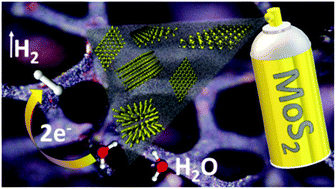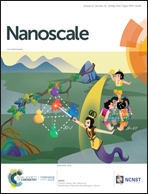MoS2 versatile spray-coating of 3D electrodes for the hydrogen evolution reaction†
Abstract
A facile one-step MoS2 spray-coating method was applied to a range of rigid, flexible, porous and 3D printed carbon-based surfaces, yielding high loadings in MoS2 flakes. The characterization of MoS2 flakes from a commercial lubricant spray reveals up to micron-scale bulk sheets of the layered material, constituted in its majority by the semiconducting 2H polymorph, in the presence of the metallic 1T phase. Consequently, the process generates MoS2 spray-coated surfaces with improved hydrogen evolution reaction (HER) catalytic performance. In the case of carbon-based screen printed electrodes (SPE), a short-term thermal post-treatment of the MoS2 spray-coated SPE had a further beneficial effect in the HER overpotential. The MoS2 spray-coated 3D metallic meshes held the lowest HER overpotential of the series. Finally, MoS2 spray-coated 3D printed electrodes yielded improved heterogeneous charge transfer and a 500 mV shift in the required overpotential at a current density of −10 mA cm−2. The MoS2 spray-coated 3D printed electrode displayed an abundant coverage at the inner, external and planar zones of electrodes by the MoS2 sheets, even after long-term operation conditions. These outcomes can be beneficial for future tailoring of MoS2 spray-coated surfaces and their implementation in energy conversion technologies.

- This article is part of the themed collection: Nanocarbons


 Please wait while we load your content...
Please wait while we load your content...